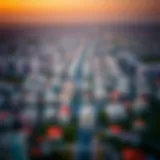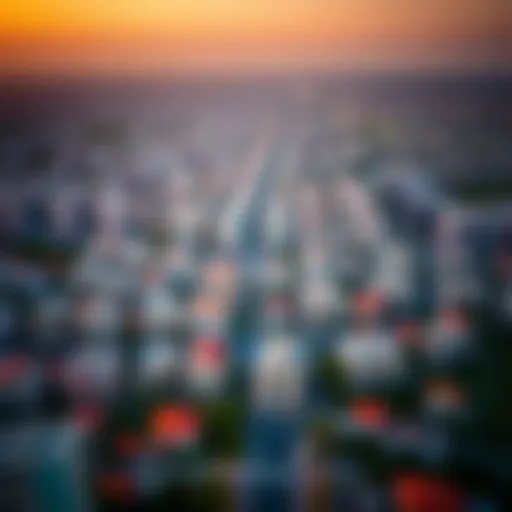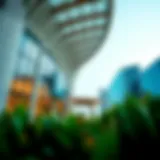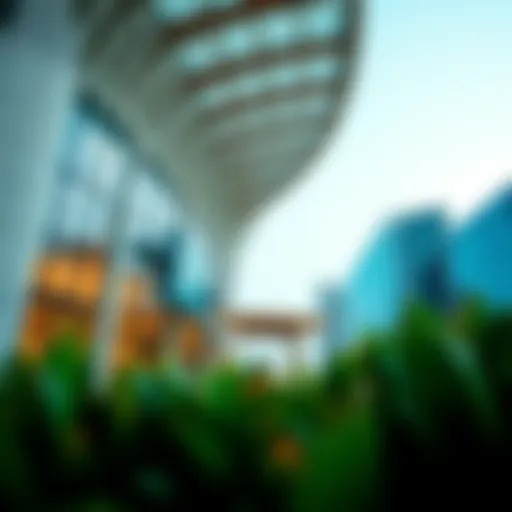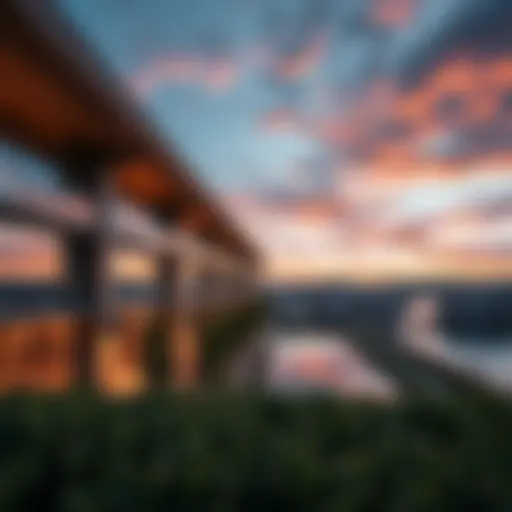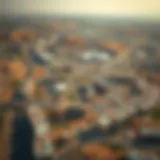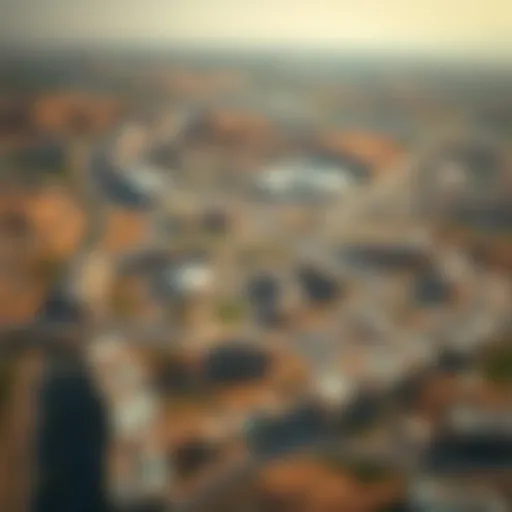Al Khail Gate Partition: Effects on Dubai's Realty
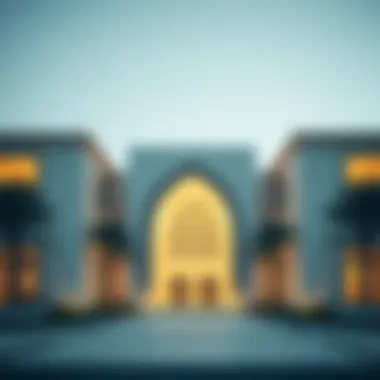
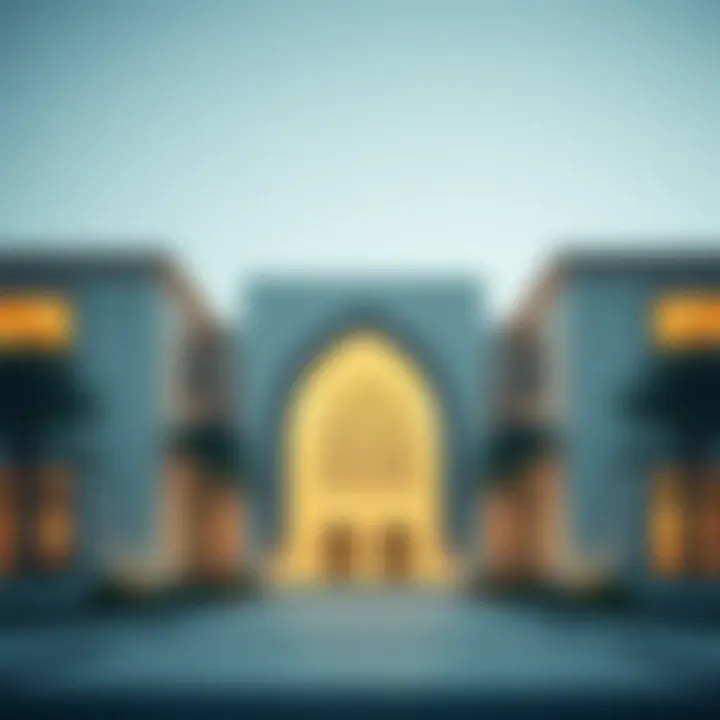
Intro
The Al Khail Gate partition stands as a pivotal element in the ever-evolving Dubai landscape. This man-made structure isn’t just about separating areas; it embodies a strategic response to the rapid urbanization of this dynamic city. The partition impacts not just the aesthetic and physical dimensions of the real estate but also the underlying economic and social fabrics of the local community. As Dubai continues to grow at a rapid pace, understanding the implications of such developments becomes increasingly vital for investors, homeowners, and industry professionals.
Market Trends
Current Real Estate Trends in Dubai
Dubai's real estate market has shown vibrant activity in recent years, with demand fluctuating in response to various economic indicators and global trends. Notably, there's been a noticeable shift towards sustainable developments. Eco-friendly residential units and commercial spaces are gaining traction, as both developers and buyers acknowledge the long-term merits of sustainability. Coupled with the proliferation of high-quality amenities, properties close to the Al Khail Gate partition are witnessing heightened appreciation in value.
Urban planners are now integrating more green spaces and community-oriented designs, suggesting that property seekers are prioritizing livability. Investors looking to make a mark will find that avenues for high-density residential structures are increasingly appealing, driven largely by governmental incentives and a booming expatriate community.
Future Forecasts for the Dubai Property Market
Looking ahead, analysts predict that the Dubai property market will continue its upward trajectory, albeit with some caveats. The economy, boosted by tourism and commerce, is likely to support real estate demand. That said, any potential economic downturn globally may temper these expectations.
"Dubai's real estate landscape is poised for growth, driven by innovative urban planning and a focus on sustainability. Investors need to keenly observe these trends to navigate the market successfully."
Key areas to watch include:
- Emerging neighborhoods around the Al Khail Gate: Opportunities for residential developments are ripe.
- Revival of commercial properties: As businesses bounce back post-pandemic, the demand for office spaces is expected to rise.
Property Types
Residential Properties: Overview and Insights
The residential sector within the vicinity of the Al Khail Gate partition is particularly noteworthy. Developers are creating residences that cater to a diverse demographic, ranging from young professionals to families and retirees. Layouts are increasingly versatile, promoting open living spaces that resonate well with modern sensibilities.
Factors attracting homebuyers include:
- Proximity to key areas: Easy access to major highways and public transport.
- Increased community amenities: Parks, schools, and retail spaces are all within reach.
- Attractive investment potential: Areas adjacent to Al Khail Gate are likely to appreciate in value, making them ideal for future investments.
Commercial Properties: Opportunities and Challenges
Commercial real estate is another fertile area, presenting both opportunities and challenges. Over recent years, companies have sought to set up shop near crucial transport links facilitated by the Al Khail Gate partition. Thus, there’s been a surge in demand for retail, office spaces, and mixed-use developments.
However, challenges such as fluctuating property values and changes in consumer behavior can affect market dynamics. Retail space owners, for instance, are urged to adapt to new shopping habits that favor online commerce. This could require reimagining how physical spaces engage shoppers.
For further information and trends on Dubai’s real estate market, you might explore resources such as Wikipedia, Britannica, or urban studies from Gov U.A.E. and local property news from platforms like Reddit and Facebook.
As the market unfolds, those involved in real estate must remain alert and adaptable, ensuring they make informed choices aligned with the shifting paradigms of this vibrant city.
Prelims to Al Khail Gate Partition
The Al Khail Gate partition serves as a pivotal element in the ongoing development narrative of Dubai's real estate market. This is not just about bricks and mortar; it’s about shaping the very experience of living and investing within this urban oasis. The significance of this partition lies in its strategic placement, ushering in an era of urban integration and impacting property dynamics in ways that resonate beyond aesthetics. By delving into its intricacies, we can garner valuable insights for homebuyers and investors alike as they navigate this bustling market.
The Historical Context
An understanding of Al Khail Gate requires a glance back through the pages of Dubai's rapid evolution. Initially, this area was characterized by scattered developments and vast stretches of land waiting for vision and purpose. As the city began to bloom in the early 2000s, the government recognized the pressing need for a cohesive urban framework. The partition was introduced not just as a boundary but as a central artery, linking communities and facilitating smooth transit across the city.
In this context, Al Khail Gate represents the ambition of a city ready to transform itself into a global hub. The partition stands as a testament to this ambition, reflecting both the historical progression of urban planning in Dubai and its commitment to sustainability and growth. It's a reminder that what seems like mere infrastructure today can mark the beginning of a new chapter in urban living tomorrow.
Purpose and Design
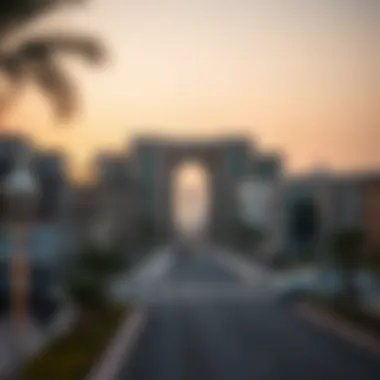
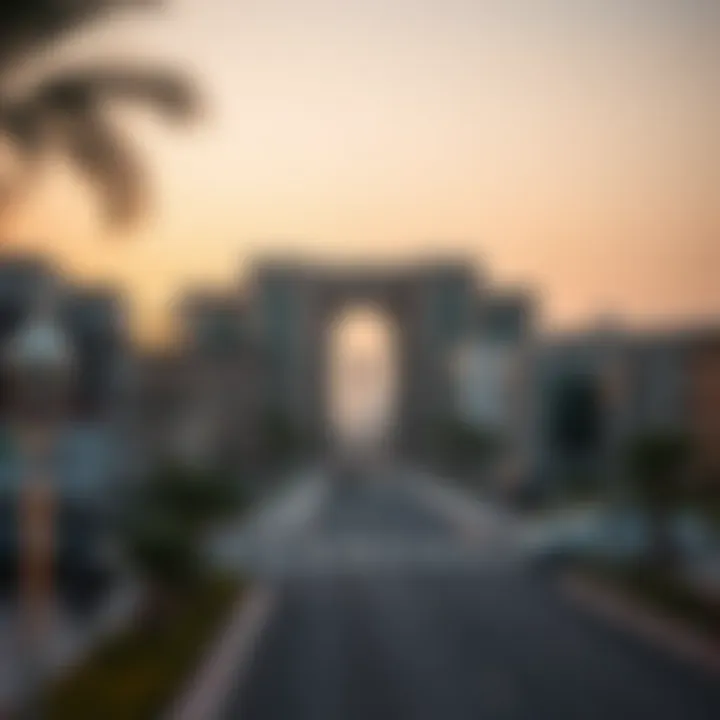
When we consider the design of Al Khail Gate, it’s crucial to grasp the underlying purposes that inform its architectural rhetoric. The partition isn't designed to separate but rather to connect—both physically and socially. Its purpose extends to managing the flow of traffic while fostering community ties. This dual role is what sets it apart as a forward-thinking initiative in Dubai’s urban planning.
Architecturally, Al Khail Gate exhibits a blend of modernist principles and traditional motifs, reflecting Dubai’s rich heritage while pushing the envelope in contemporary design. The use of open spaces encourages local gatherings and activities; it is a design that promotes a sense of belonging among its residents. By ensuring accessibility and aesthetic appeal, the partition enhances the livability of the districts it encircles, thereby positively influencing property values.
"The Al Khail Gate serves both as a passage and a pause, an invitation to engage with the dynamic urban tapestry of Dubai, where every brick tells a story of progress and possibility."
In summary, the Al Khail Gate partition is a focal point of Dubai’s urban landscape—its historical significance provides context, while its carefully considered design reveals the intent to unite disparate communities, creating not just a physical barrier but a welcoming environment that invites investment and growth.
Architectural Features
Exploring the architectural features of the Al Khail Gate Partition reveals a fascinating intersection of form and function. This section is crucial as it provides insights into how well-designed structures contribute not just to aesthetics but to the overall functionality of urban environments. Given the rapid development in Dubai's real estate market, understanding these architectural components can inform investors, homebuyers, and analysts alike.
Structural Elements
The structural integrity of the Al Khail Gate Partition is paramount to its role in Dubai's urban framework. Designed with durability in mind, the partition utilizes reinforced concrete alongside innovative construction techniques that ensure longevity and adaptability to the harsh desert climate.
The following are key structural features of the partition:
- Reinforced Concrete: Providing strength and resilience to withstand high winds and seismic activities.
- Dynamic Load Distribution: The shape of the partition is engineered to evenly distribute the forces acting upon it, preventing undue stress on any single point.
- Sustainable Materials: The use of eco-friendly materials in construction is a focal point, aligning with global sustainability trends.
These elements not only enhance safety but also contribute to the partition's iconic silhouette that defines the surrounding skyline. As a result, this makes it a significant landmark, fostering an identity for new developments nearby.
Aesthetic Considerations
The aesthetics of the Al Khail Gate Partition go hand in hand with its structural design, illustrating how form can complement function. The clean lines and modern architectural style create a visual harmony that resonates well with Dubai’s avant-garde ethos. Importantly, the design doesn’t merely cater to aesthetics; it embodies a deep understanding of cultural context and community engagement.
Factors influencing the aesthetic appeal include:
- Modern Design Principles: The minimalist yet impactful design reflects contemporary architecture that is both practical and visually striking.
- Cultural Resonance: Incorporating elements inspired by traditional Middle Eastern architecture, the partition maintains a connection to the heritage of the region.
- Lighting and Landscape Integration: Strategic placement of lighting enhances the exterior at night while landscaping around the partition creates a welcoming environment for pedestrians.
"Architecture should speak of its time and place, but yearn for timelessness."
In this case, the Al Khail Gate Partition successfully communicates Dubai's modern aspirations while respecting the historical narrative of the region. Its aesthetic presence not only elevates the surrounding area but also encourages community interaction and integration.
Understanding these architectural features is essential for stakeholders in the real estate landscape, as they inform how new projects can align with existing structures and urban environments, ensuring cohesion and enhanced property value.
Urban Impact
The Al Khail Gate partition represents a pivotal element in the urban landscape of Dubai. Its significance extends far beyond its physical structure; it embodies a strategic response to the challenges and opportunities faced by this rapidly growing metropolis. With a view toward expansive urban growth and the integration of modern infrastructure, this section delves into how the partition has reshaped urban dynamics and impacted the community.
Managing Urban Growth
As the population of Dubai swells, managing its journey into the future becomes more crucial. Al Khail Gate serves as a literal and figurative barrier—guiding urban expansion while promoting organized growth patterns. The partition has made it easier to delineate development zones, ensuring that residential and commercial spaces can coexist without overcrowding.
This effectively manages traffic flow in some of the busiest parts of the city.
- Key Benefits:
- Zone Management: By facilitating specific land usage, Al Khail Gate enables planners to designate areas for residential, commercial, and recreational purposes, fostering harmonious urban retreats.
- Population Density Control: Preventing overpopulation in some districts leads to better living conditions and enhanced quality of life.
- Sustainable Development: The careful planning around the partition promotes sustainable growth, allowing overall urban development to be better aligned with the environment.
In practice, this means fewer traffic snafus and easier access to essential services. Local governance becomes more streamlined, creating an efficient administrative environment that encourages both investment and community engagement.
Influence on Local Infrastructure
Dubai's vision stretches into the impressive infrastructure that supports its residents. Al Khail Gate plays a crucial role in shaping the infrastructure surrounding it. Roads leading to and from the partition have been upgraded, leading to improved connectivity between neighborhoods and the central business district. This accessibility attracts businesses and residents alike, boosting the local economy.
The enhanced transport links have fostered a network that helps reduce commute times, allowing people to go about their lives with less hassle.
Moreover, the partition acts as a catalyst for new infrastructure projects, as developers tend to favor areas with clear boundaries and defined access points.
Here are a few notable impacts:
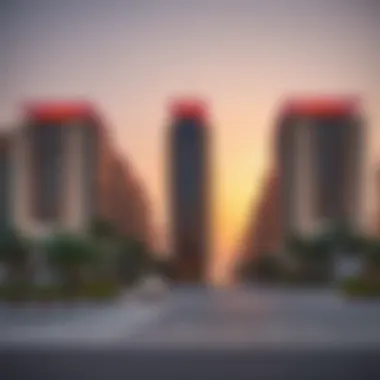
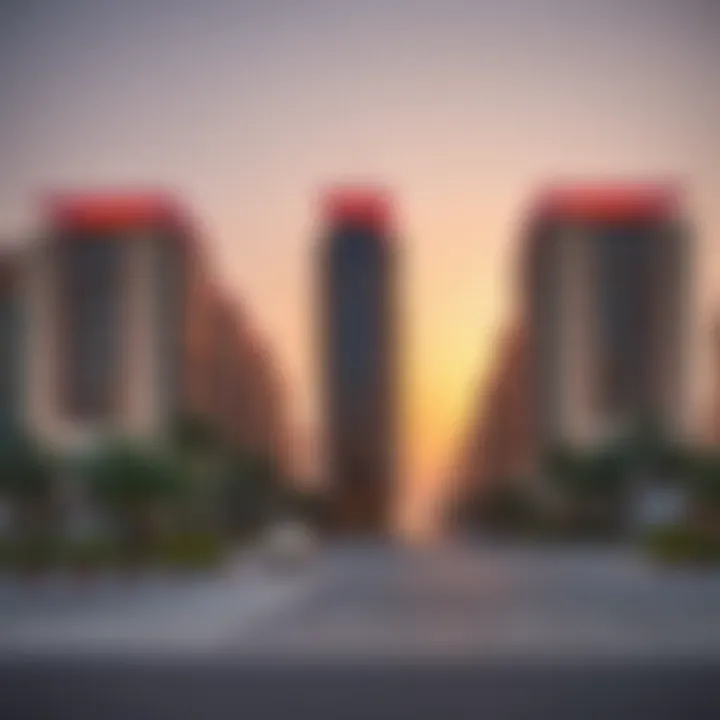
- Enhanced Transport Systems: New roads and public transport options are emerging, directly tied to the presence of Al Khail Gate.
- Utility Expansion: Water and electricity services are also seeing improvements, ensuring that the growth of housing and commerce can be supported adequately.
- Community Amenities: With urban planners taking cues from the partition's structure, parks, educational facilities, and shopping centers have sprung up, greatly enhancing the livability of the area.
In sum, the Al Khail Gate partition is not just a physical barrier; it is a vital component of Dubai's urban fabric that actively influences growth, infrastructure, and accessibility for its diverse populace. As this landscape continues to evolve, the lessons learned from the Al Khail Gate experience will illuminate paths for other rapidly developing cities.
Economic Implications
The economic implications of the Al Khail Gate Partition are fundamental to understanding its role in Dubai's real estate environment. This development isn't just another feature on the skyline; it serves as a catalyst that shapes market dynamics and creates new economic opportunities. As a major component of the urban landscape, it directly influences property values and investment potential, making it an essential topic for investors, homebuyers, agents, analysts, and developers alike.
Effect on Property Values
When evaluating the effect of the Al Khail Gate Partition on property values, it's important to consider several factors. For one, its strategic location acts as a linchpin that enhances accessibility to various parts of the city. Properties near the partition tend to appreciate in value more rapidly due to their desirability. The convenience of travel and trade around the area propels demand, accumulating interest from both residential and commercial sectors.
Moreover, with the surge in population density, there is often more competition among buyers, which can drive prices higher. Investors are increasingly viewing the area as ripe for residential and retail projects, boosting overall market sentiment.
- Increased foot traffic from these developments directly contributes to rising property values.
- As businesses flourish adjacent to the partition, residents become more inclined to invest in real estate around the area, further elevating prices.
In some cases, gentrification plays a role here, as older buildings may undergo renovation or replacement with modern structures. These transformations can make a neighborhood more appealing, attracting wealthier residents and escalating property values.
Investment Opportunities
The Al Khail Gate Partition opens up a multi-faceted world of investment opportunities for individuals and corporations. For savvy investors, this area presents a fertile ground due to its projected growth trajectory. The partition not only makes logistics easier but also enhances the neighborhood's attractiveness, therefore drawing investors from different sectors.
- Commercial Real Estate: Given the uptick in foot traffic, businesses recognize the potential of setting up shop near the partition. Retail spaces and offices are particularly hot commodities in this high-traffic area.
- Residential Projects: With rising property values, residential developments are increasingly appealing. Investors have a chance to capitalize on this upward trend by partnering with developers to construct new housing units that cater to the growing population.
- Strategic Partnerships: Collaborating with local businesses can uncover joint ventures that create mutually beneficial opportunities, further enhancing investment returns.
The partition is not merely a physical divide; it symbolizes the economic promise that characterizes Dubai as a booming metropolis. Its comprehensive integration into the existing infrastructure elevates the area, making it a key player in the long-term economic landscape.
The Al Khail Gate Partition is not just an architectural feature; it’s a beacon indicating where economic revitalization is heading in Dubai.
Social Dynamics
Understanding social dynamics is pivotal in the context of Al Khail Gate Partition as it serves not only as a physical barrier within Dubai's urban sprawl but also as a catalyst for community development and the integration of diverse populations. Social dynamics encompass how individuals and groups interact and how these interactions shape the fabric of society. As Dubai continues to evolve, examining these dynamics helps in appreciating the multifaceted impact that the partition has on its residents.
Community Development
The community development aspect around the Al Khail Gate Partition is striking. This structure is positioned at a strategic point that connects various neighborhoods and acts as a gateway for residents. By promoting connectivity, Al Khail Gate enhances access to essential services like schools, parks, and healthcare facilities. This accessibility is crucial for fostering a sense of community among residents, who come from various backgrounds.
Furthermore, local businesses around Al Khail Gate have seen an uptick in patronage due to increased foot traffic. Many residents appreciate having grocery stores, cafes, and retail shops nearby, making daily life straightforward. The increased demand for these services can spur further investments, leading to improved infrastructure and amenities in the area, ultimately contributing to better living conditions.
Building a community extends beyond just physical structures. Encouraging local events and initiatives can enhance community ties. Organizing cultural celebrations or farmers' markets can create spaces where residents meet and interact. This communal interaction not only strengthens local ties but also promotes the understanding of diverse cultures within the area.
Integration of Diverse Populations
Integration of diverse populations is another key feature influenced by the Al Khail Gate Partition. Dubai is renowned for its melting pot of cultures, where residents hail from all corners of the globe. The partition's presence has brought together various communities, enhancing social integration.
This integration manifests in several ways:
- Shared Spaces: Parks and recreational areas near the partition facilitate gatherings where people from different backgrounds share experiences, stories, and cultures.
- Cultural Exchange Programs: There is great potential for organizing workshops or classes reflecting the various cultures represented, which can lead to greater understanding and camaraderie among residents.
- Language and Education Initiatives: Given the diverse linguistic backgrounds, incorporating language exchange programs or educational workshops can help break barriers and foster friendships.
Moreover, this section of Dubai is seeing an increase in mixed-use developments that cater to different demographics. Such buildings foster interaction among residents, enabling them to build networks of support and understanding. While there are challenges, the Al Khail Gate Partition serves as more than just a physical separation; it helps in weaving a diverse yet cohesive community tapestry, something crucial for the future of Dubai's urban landscape.
“The real key to Dubai's success is its ability to adapt and integrate cultures, making every community feel at home.”
Challenges and Criticisms
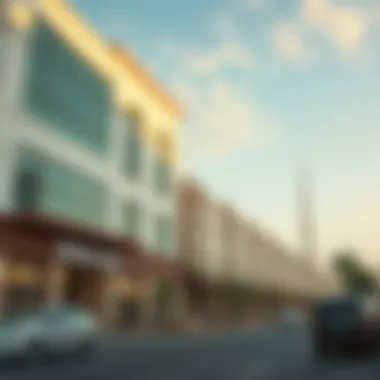
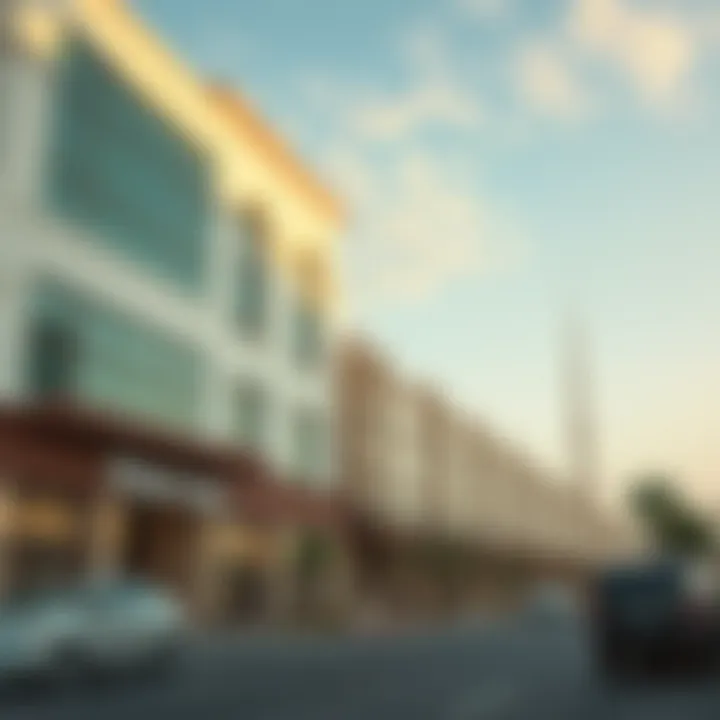
The Al Khail Gate partition, while influential in Dubai's real estate landscape, does not come without its share of challenges and criticisms. Understanding these aspects is essential, particularly for investors, homebuyers, and city planners who seek a comprehensive grasp of the repercussions tied to such a monumental development. Concerns raised often center around two primary areas: environmental impact and displacement of local communities. Addressing these issues not only clarifies potential pitfalls but also paves the way for more thoughtful urban planning in the future.
Environmental Concerns
Environmental considerations remain a hot topic in Dubai, especially as the city attempts to balance rapid growth with sustainability. The Al Khail Gate partition has raised valid criticisms regarding its ecological footprint. Naysayers point to the increased concrete footprint as a contributing factor to heat retention and disruption of local wildlife habitats. Urban sprawl, often portrayed as a necessary evil for development, casts a shadow over the natural palette Dubai once offered.
Some argue that the landscape alteration ignites a myriad of secondary issues, including increased air pollution due to construction activities and heightened traffic congestion. For instance, during the project's initial phases, residents nearby experienced a noticeable uptick in disturbances – dust, noise, and traffic snarls were chalked up as everyday inconveniences. However, the overarching concern remains whether developers and planners are prioritizing ecological sustainability or merely succumbing to the rapid demand for new properties.
Furthermore, temporary construction practices often lack rigorous adherence to best environmental management practices. With recent trends in green architecture, there’s a growing push towards incorporating sustainable materials and methods in developments, which may not have been the case during the Al Khail Gate construction.
"Sustainable development should not be a choice, but a requirement. We cannot afford to ignore our ecological responsibilities as we build."
Displacement Issues
The Al Khail Gate partition also raises significant displacement issues, drawing attention to the social fabric of Dubai. Many current residents find themselves under the shadow of the partition’s towering structures. While developers may tout economic growth and rising property values, the narrative often overlooks the effects on established communities. As property values rise and low-income neighborhoods face redevelopment threats, a troubling pattern emerges: displacement.
Cohesive communities are often disrupted, forcing long-standing residents to seek housing elsewhere or move further from their places of work. This dislocation can lead to a breakdown in social structures that have developed over generations. Critics note that fulfilling the vision of a modern Dubai comes at the cost of erasing the rich cultural tapestry that existed prior to aggressive expansion.
The emotional toll, often underestimated, can lead to increased anxiety and social friction among displaced populations. Furthermore, while some housing projects aim at affordable living, they often attract a different demographic, deepening the social divide. As these tensions simmer, stakeholders must consider not only economic indicators but also humane factors in planning for the future.
Future Projections
The Future Projections section is crucial for reflective analysis regarding the Al Khail Gate partition and its anticipated role in shaping Dubai's real estate landscape. Understanding these projections can help investors, homebuyers, agents, analysts, and developers grasp how the partition might influence various facets of the market. This foresight is instrumental for making informed decisions and strategies to adapt to the unfolding dynamics in this bustling urban environment.
Anticipated Developments
In the coming years, Al Khail Gate partition is set to see significant developments. Various projects are already in the pipeline aimed at improving connectivity, enhancing security, and fostering community engagement. Below are some key anticipated developments:
- Enhanced Transportation Networks: Additional access roads and public transport options are likely, potentially including metro extensions to lessen road congestion.
- Commercial Growth: With demand for commercial spaces on the rise, new office complexes, retail outlets, and entertainment facilities are projected to fill the area.
- Residential Expansion: An influx of housing options, ranging from luxury apartments to affordable housing, will likely cater to the diverse demographics moving into Dubai.
- Green Spaces: Planners are increasingly focusing on sustainable design. Expect to see public parks and recreational spaces integrated into new developments.
These changes have ripple effects, as they not only enhance property values but also improve the overall living standards for residents.
Long-Term Economic Outlook
The long-term economic outlook for the area surrounding the Al Khail Gate partition is promising. As Dubai continues to position itself as a global business hub, the partition stands to play a pivotal role. Key considerations include:
- Economic Resilience: Dubai has shown remarkable recovery patterns through economic cycles, leading to an expectation of sustained property demand due to a diversified economy.
- Rising Property Values: Experts predict property values will see continual appreciation driven by increased demand for residential and commercial spaces as nearby facilities develop.
- Investment Opportunities: The evolving landscape is generating a plethora of investment opportunities. Developers and investors are likely to find avenues in the foundational infrastructure needed to support the burgeoning population.
- Integration with Smart City Initiatives: The integration of smart technologies in new buildings and infrastructure will enhance operational efficiency, attracting tech-savvy businesses and residents.
"Investing in Al Khail Gate is not just about bricks and mortar; it's about anticipating the trends that will define the future of Dubai."
In summary, the future projections related to the Al Khail Gate partition are woven into a broader tapestry of Dubai's strategic urban planning and economic ambitions. For stakeholders, these insights provide a roadmap to navigate through this evolving real estate market.
The End
The discussion surrounding the Al Khail Gate partition highlights its meaningful role in the intricate tapestry of Dubai's real estate landscape. This article has traversed various dimensions of this pivotal structure, emphasizing not just its architectural prowess but also its broader implications on urban growth, economic vitality, and social integration within the region.
Recap of Findings
Delving into the various sections provides a structured understanding of how the Al Khail Gate partition interacts with numerous aspects of city life. Key findings include:
- Architectural Significance: The unique structural elements blend functionality with aesthetic appeal, contributing not just to the skyline but also defining urban experiences.
- Urban Management: It serves as a critical component for managing the rapid urban growth seen in Dubai, effectively directing traffic and fostering connectivity between thriving neighborhoods.
- Economic Impact: Property values have shown positive trends in the vicinity of the partition, making it an attractive prospect for investors looking to capitalize on Dubai's booming market.
- Social Integration: The partition has catalyzed community development initiatives, successfully integrating a diverse range of populations while promoting cultural harmony.
These points encapsulate the foresight and planning that have shaped Al Khail Gate into a significant element of Dubai's urban planning strategy.
Final Thoughts
The Al Khail Gate partition goes beyond its physical presence. Its resonance is felt through the elevated interaction among communities and the economic uptick within real estate. Investors and developers are faced with a landscape ripe with opportunities that this development has created. However, it also urges stakeholders to be conscious of the underlying challenges, from environmental concerns to the displacement that can come with urbanization.
Understanding this nuanced impact is crucial. As Dubai continues to evolve, the lessons gleaned from the Al Khail Gate partition will undoubtedly provide a blueprint for future developments aiming for harmony between growth and community welfare.
“The future belongs to those who believe in the beauty of their dreams.” – Eleanor Roosevelt
This sentiment captures the essence of what the Al Khail Gate partition embodies; it’s a dream realized through careful planning and unwavering vision.
